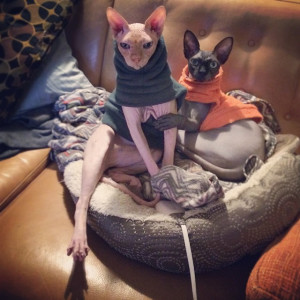
Even cats appreciate a high-quality cat-hair sweater. (Image: https://www.flickr.com/photos/thetopaz/)
This is called the “sales cycle,” and it measures the time span between making the first meaningful contact with a prospect to a finalized sale. The sales cycle provides you with that final piece of information you need to fully understand your sales performance, allowing you to create accurate sales predictions into the future. This is especially useful for companies that haven’t yet reached a profitable stage, allowing them to accurately estimate their capital needs as they approach profitability.
Let’s take a look at how this works by way of example. On the Success In Business Podcast, co-host Jason Pyles and I have created a purely fictional company called “Kickass Cat Sweaters.” It’s a startup fashion brand that turns discarded cat hair into luxurious sweaters, making it a perfectly absurd example for demonstrating some basic business concepts.
Kickass Cat Sweaters is a new company, so it doesn’t have much in the way of sales data. It’s brand new startup, so we’re going to have to replace real data with our best guesses. After some discussion and debate about our amazing value proposition, we decide that the average sale will be $49.95. (Later, when cat-sweater mania sweeps the nation, we can revise our model.)
Next, we have to determine what it costs for us to sell this beautiful piece of hand-crafted, “100% hyper-allergenic” clothing. We have to consider the cost of the raw materials (the cat hair), the cost of production (turning cat hair into yarn, specialized knitting machines, product care labels), packaging, shipping, and credit card fees. After crunching the numbers, we determine it costs $25.95 per sweater. This means we have a gross margin of $25.
Here’s the breakdown:
- Total Cost: $24.95
- Product cost: $18.95
- Packaging: $1
- Shipping: $3.50
- Credit card fee: $1.50
- Retail Price: $49.95
- Gross Margin ($49.95 – $24.95): $25
Now that we’ve figured out our gross profit, we need to take a look at our overhead. We’re going to need rent for our manufacturing and warehouse space, we have salaries to pay, and we have a host of other costs like insurance and utilities. (Not to mention ordering lint rollers by the pallet.) These fixed costs will also take a bite out of our overall profits. After some simple math, we discover that our overhead is $150,000 a year.
By dividing our fixed expenses by our average gross profit, we now know the number of sales we have to make in order to break even. It looks like we’ve got to sell 6,000 Kickass Cat Sweaters every year before we see a profit.
Here’s what it looks like:
- Operating & fixed expenses (rent, insurance, salaries): $150,000/year
- Gross profit divided by fixed expenses ($150,000/25) = 6,000
- Annual sales needed to break even: 6,000
Now that we know our breakeven point, we can start to play around with some “What if?” scenarios. For instance, “What if our gross profit was $50 instead of $25?” Maybe we could go the luxury route, and only make our cat sweaters with the finest quality hair from pedigreed Longhair Persians. Then we could charge $99.95 per sweater, offsetting the increased raw materials costs and creating a higher margin.
We could even try creating a “companion set” of matching sweaters for cat owners and their pets. Perhaps we even have an upgrade where the human-sized sweater has a photo of their pet cat on it, and the cat-sized one has a photo of their owner. That’s a premium product if there ever was one, and a steal at just $99.95!
With a gross profit of $50, we now only need 3,000 sales to break even. But we’re not done yet. Now we need to start setting some profitability objectives, and charting the path of how we’re going to get there.
As a startup, Kickass Cat Sweaters is going to have a lot of up-front costs. We’re also building up an entirely new market, and finding our customers might take a little time. In the early stage of the company, our expenses will be more than the money we can bring in through sales. This means negative profits — losses that will need to be covered — for a period of time. We need to have a plan for keeping the business open while we build the sales momentum needed to bridge that deficit.
It’s also useful to build projections. What does the company look like at 2,000 sales? What about 4,000? What will our numbers be when “cat-sweater mania” takes the country by storm, and we need to scale the operation to handle 300,000 annual sales?
As we grow the company, we’ll also be able to take advantage of the economy of scale. The more cat hair we can buy in bulk, the lower the price. Perhaps this means it only costs us $23.50 to make a sweater now, changing our breakeven point.
Of course, cat sweaters are a new market. To make those sales happen, we may need to bring on some salespeople to help us establish our customer base. How much should we pay them? How do you even determine fair compensation?
I’ll talk about Pay, the Third P of Sales, in my next post.
